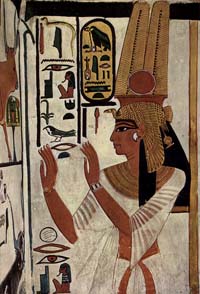Nefertari
Nefertari was the wife and queen of Ramses II. She lived during the New Kingdom Period and was a member of Egypt’s 19th Dynasty. Nefertari’s known biography begins after her husband became Egypt’s ruler. Scholars know little about her family or past but they can make some assumptions based on her titles.
Who was Nefertari?
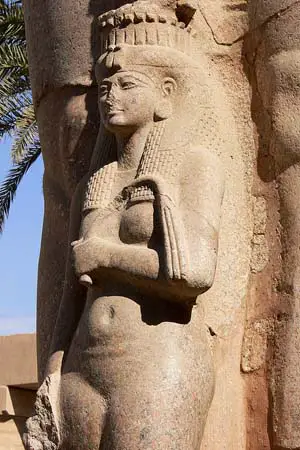
© Walwyn - Nefertari statue at Karnak
Her name, Nefertari Merytmut (meaning The Beautiful Companion, Beloved of Mut), embodied the majesty and stature of queen Nefertari. At the young age of 13 she married the 15 year old Ramses II, who would come to be famously known as Ramses the Great.
Nefertari was likely a noblewoman but not a member of the royal family. She uses the titles associated with a noblewoman but no titles calling herself a king’s daughters. Records say that Ramses II and Nefertari were married before he ascended the throne. Official records mention her from the first year of his reign.
Family
Ramses II ruled Egypt for sixty-seven years and had seven different queens. The first of these was Queen Nefertari. Ramses II lived for over ninety years and fathered at least forty daughters and forty-five sons. Nefertari was the mother of at least four sons and two daughters.
Artifacts help identify the mothers of some of Ramses II’s children. However, most of the time, scholars had to make assumptions about a child’s mother based on where his/her images have been found. The four princes believed to be Nefertari’s sons were Amun-her-khepeshef, Pareherwenemef, Meryatum and Meryre. Two princesses identified by scholars as Nefertari’s daughters were Meritamen and Henwttawy. Some scholars speculate that she may have had other children, but no evidence has proved this.
Ramses II and Nefertari
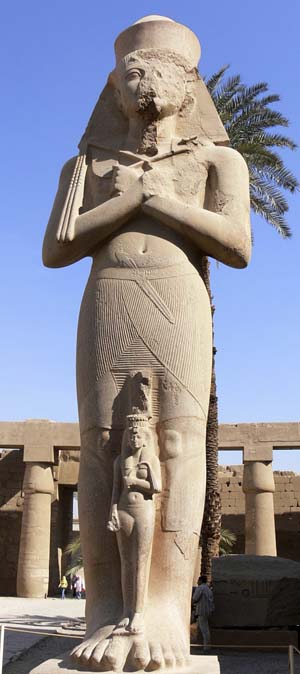
© Walwyn - Statue of Ramses II and Nefertari
Nefertari was Ramses II’s wife for over 24 years. What was probably a politically inspired union would, over time, blossom into an amorous relationship wherein Ramses II celebrated his love for her with monuments and poetry dedicated to her honor. The many titles ascribed to her attest to the esteem Ramses held for her and the various roles she undertook in her function as queen. Designations such as Sweet of Love, Bride of God and Lady of the Two Lands, demonstrate her positions as lover, priestess and political functionary. She is known to have even accompanied Ramses, in some cases, on military campaigns.
Egyptologists have found statues and images of Nefertari throughout Egypt. At Luxor, statues of the queen are at the foot of giant statues of Ramses II. Other images show her leading the royal children in rituals or during festivals. Images also show Nefertari with her husband honoring the gods or commemorating events.
Scholars have found more evidence of Queen Nefertari’s importance in the capital city of the Hittites. Early in his reign, Ramses II was at war with the Hittites but a peace treaty was established during his reign. After they made peace, Nefertari wrote letters to the king and queen of the Hittites. She also sent gifts to the queen, including a gold necklace.
Nefertari’s Tomb
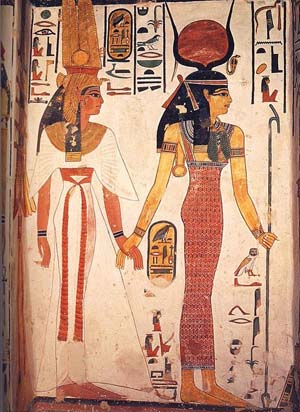
© Lucas - Depiction of Nefertari (left) on the wall
of her tomb, with goddess Hathor
Ramses II built a beautiful tomb for his wife in the Valley of the Queens near Thebes. It is now known as QV66 and is the largest and most beautiful tomb in the valley. Thieves stole all the queen’s grave goods in antiquity, including her sarcophagus and her mummy. Egyptologists only found fragments of Nefertari’s body and a few grave goods in the tomb.
Nefertari’s tomb is known for the beautiful and well preserved wall paintings. Some of them depict the crown of Queen Nefertari. Often, she wears a crown associated with different goddesses like Isis or Hathor. In her tomb, the wall paintings show the queen honoring the gods and goddesses who would help her on her journey in the afterlife.
The ceiling of the tomb is blue and has stars painted over the ceiling. Most of the wall paintings were well preserved and Egyptologists have worked to restore and protect them. Today, The Egyptian government controls and limits visitors to the cave. Hieroglyphics cover the walls and many are passages from the Book of the Dead. Most of the images are pictorial depictions of several chapters from the Book of the Dead.
Queen Nefertari’s tomb represents a key cultural image for two reasons. The first is that the tomb’s preservation gives scholars a glimpse of the beauty and color that was a part of most royal tombs. Second, it demonstrates the building expertise of artisans during Ramses II’s reign. Some scholars regard her tomb as one of the greatest of the many works completed during his reign.
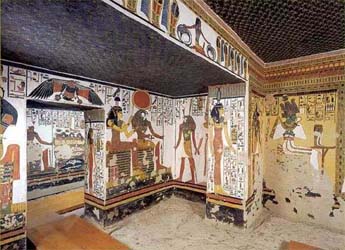
© omdaa - The Tomb of Queen Nefertari
Abu Simbel Small Temple
Abu Simbel is the location of two rock cut temples that Ramses II built in Nubia. The Great Temple was dedicated to Ramses II and several national gods. Images of Queen Nefertari and several of the royal children are on the temple. Scholars moved both temples, during the 1960s, to save them from flooding caused by the Aswan Dam.
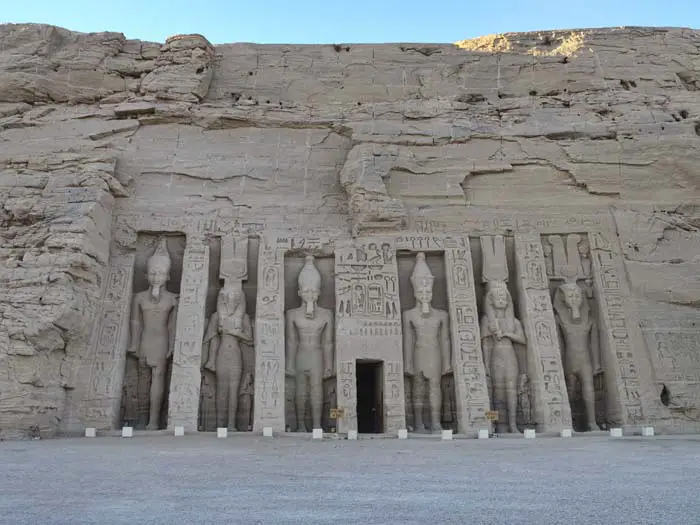
© Dan Lundberg - The Small Temple at Abu Simbel
Ramses II dedicated the Small Temple to Nefertari and the goddess Hathor. Two colossal statues of the queen and four of Ramses II were carved on the front of the temple. Smaller statues of the royal children are beside the colossal statues. Inside the temple is a large Hypostyle hall.
The Hypostyle columns have tops carved in the shape of Hathor’s head. Two small vestibules were on either side of the main hall on the end by the sanctuary. The sanctuary was opposite the front entrance of the temple. All the carvings in the sanctuary were completed. Scholars found two areas on the wall for doorways to other chambers that were not carved.
Abu Simbel’s construction began in the twenty-fourth year of Ramses II’s reign. Nefertari appears in the images depicting the beginning of the temples’ construction. Later images show her daughter Meritamen in her place. Scholars believe that this shows the queen was in ill health at this time. She likely died not long after the Abu Simbel’s construction began.
Queen Nefertari Facts
- Nefertari was the first queen of Pharaoh Ramses II.
- She died in the twenty-fourth year of his reign.
- Her tomb is the most beautiful found in the Valley of the Queens.
- Scholars found love poetry written by the king for his dead queen in Nefertari’s tomb.
- Ramses II dedicated the Small Temple at Abu Simbel to Nefertari and Hathor.

